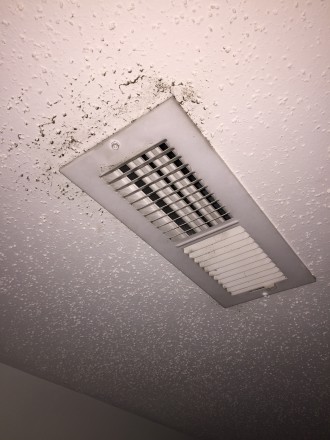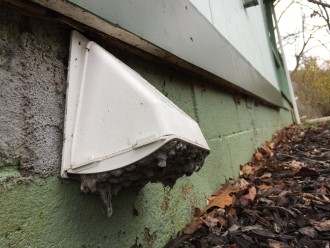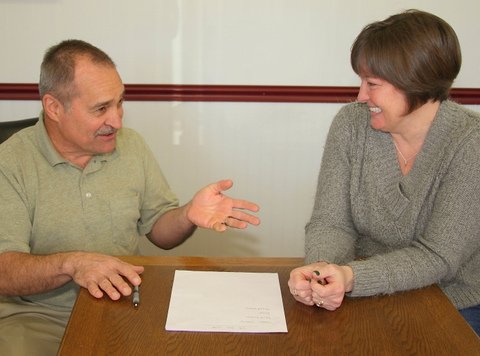Are you feeling lightheaded, weak or groggy this winter? Forget the flu; your home could be making you sick. The Environmental Protection Agency ranks indoor air pollution among the top five environmental risks to public health.
“It makes sense, if you think about it,” says Ashley Featherstone, permitting program manager for the Western North Carolina Regional Air Quality Agency. “The solution to pollution is dilution: If you’re outside in your yard, you’re in such a large air mass. But indoor pollutants can’t be dissipated.”
We would never knowingly put our families or ourselves at risk, yet thousands of Buncombe County residents do it every day. “There’s a lot of unhealthiness among conditions inside houses,” says Rick Bayless, whose company, A Healthier Home, conducts assessments and energy audits for homeowners. “Every place I go it’s the same old story: They are ecological and environmental disasters. It’s terrible out there.”
The problem is so common that there’s even a name for it: sick building syndrome. “Maybe the term ought to be sick occupant syndrome,” says Bayless, “because who cares if a house is sick?”
And though most folks spend about 90 percent of their time indoors, indoor air quality isn’t something they’re typically thinking much about. That’s partly because many of the contributing factors aren’t visible. But by the time we start experiencing symptoms, the problem may already be out of control.
Take radon, for example, a colorless, odorless gas caused by the decay of radioactive elements in the soil. “Radon is a naturally occurring rock,” explains Maggie Leslie, program director for the Green Built Alliance. “We can’t test a site before we build on it, and so you never know if radon is there. Once you put a home slab down the radon can’t escape: It’s trapped under there, and so it builds up pressure, becomes more concentrated and seeps into the house.”
Buncombe County is rated zone 1, which means the average indoor radon level in screened homes is greater than 4 picocuries per liter. At or above that level, the EPA recommends taking measures to reduce exposure. Radon, says the agency, is the second-leading cause of lung cancer in the U.S. and the No. 1 cause among nonsmokers.
Hidden in plain sight
But radon is only one of a number of common indoor air culprits. Leaking carbon monoxide from combustion appliances such as gas or oil furnaces can also be deadly.
Volatile organic compounds are another big contributor to poor indoor air quality. “Formaldehyde is one of the most common VOCs that we have in our homes. It’s in a lot of things like paints and glues,” Leslie explains. Laminate countertops, plywood, particleboard and other common building materials are glued together. When that glue dries and cures, it off-gasses into our indoor environment. “That new home smell? Those are VOCs. My understanding is that it takes about 10 years to completely off-gas, but it does drop considerably after the first year or two,” says Leslie.
Even common household items can cause problems. “A lot of people have attached garages, and they might have a gas can with gas for their lawn mower,” notes Featherstone. This, she continues, can create exposure “to the highest concentration of benzene indoors.”
Candles and, ironically, air fresheners can also be hazards. “Those plug-in air fresheners emit paradichlorobenzene, which has been shown to reduce lung function in healthy adults,” adds Featherstone.
Lead-based paints were banned for use in housing in 1978, but they may still be present in some older homes. Lead exposure is particularly problematic in children — it can cause developmental issues — but inhaling it is a bad idea at any age. If you’re remodeling a room with lead-based paint, or sanding the paint itself, “Be careful to minimize any dust,” advises Featherstone. Home-improvement stores sell kits to test whether your paint is lead-based, which can be a problem even if it’s been covered with water-based paint.
Everyday cleaning products are also potential health hazards. “You’re bringing in these harsh chemicals that are hard to breathe,” says Leslie, adding, “Make sure you can exhaust the air in your home if you’re using those products.”
Out of bounds

One of the best-known and most-worried-over causes of poor indoor air quality is mold. Featherstone says her office regularly hears from folks who want their homes tested for mold, but she says the testing really isn’t necessary, since there are no definitive standards for mold levels. “If you have visible mold in your house, we recommend addressing that, no matter what type it is. It’s all allergenic and potentially unhealthy. You don’t need to know the exact species: We just recommend fixing the problem,” she explains.
Bayless agrees. “You’re not supposed to see mold,” he points out. “It’s a microscopic organism, for heaven’s sake. When enough of those are establishing a colony and you can start to see those speckles with the naked eye, it’s already gotten out of bounds.”
Largely unregulated
Although both the Occupational Safety and Health Administration and the North Carolina Department of Labor regulate indoor air in the workplace, residential spaces are mostly ignored. “Indoor air quality is not regulated by the EPA,” says Featherstone. She and her colleagues at the air agency do issue permits for demolition and renovation work involving asbestos, but not for hazards such as mold and radon.
Folks who had their home inspected before buying it may think it was tested for indoor air quality problems, says Bayless, but that’s probably not the case. “Part of the reason I started my business was I recognized that homeowners weren’t getting any kind of perspective on house performance and healthiness,” he says. “The home inspector guidelines are for home sale purposes; inspectors are given freedom to ignore house performance. Homeowners are on their own with this stuff.”
Taking action
We can’t all go out and buy a brand-new, green-built home, so what’s a homeowner to do? The first step, says Featherstone, is just to pay attention. “We recommend doing a walk-through and looking for obvious things.”
When Bayless does his healthy home inspections, he considers eight factors: clean, dry, safe, maintained, ventilated, toxin-free, pest-free and thermally conditioned. “If you don’t know where to start, look at the house from those eight perspectives,” he advises.

The good news is, even if your home has less than perfect indoor air quality, there are solutions. Carbon monoxide detectors will alert the homeowner to leaks. Mitigation systems that pull radon from beneath the house and vent it outside can be installed at any time. Good ventilation can reduce exposure to VOCs, lead-based paint can be contained and properly removed, nontoxic cleaning products are widely available, and mold can be killed, cleaned and the causes addressed.
“Maybe we can’t do anything about outdoor environmental degradation,” says Bayless. “But we absolutely can do something about indoor conditions.”



As Green and Healthy home design consultants we at Hempfully Green cannot emphasize enough the purpose of going fragrance free. By example, I just rid someone’s chicken yard of a rat infestation by pushing fabric softeners down their entrance holes, now you smell the stink of dead rats. Hempcrete, our specialty is at the top of wall systems that deny mold. Hempcrete denies pests and fire as well. There’s reason to check out this technology in its early stages of adaptation in the US.
Great point! Going fragrance-free and avoiding scented candles are both ways to improve indoor air quality.
This warning should also be for renters. Owners of properties often do not care about the health safety inside their buildings. Rather, they insure that the outside look beautiful so their greed for money will be satisfied. I’m a homeowner, and I am searching for an apartment to retire to. In my search, I happened to go to River Ridge Apartments, and found a well-kept outside, but poorly maintained inside conditions (black mold), and residents complained of a uneffective staff. The safety of owners and tenants insures income for everyone. Great article!
Yes, this is an important issue for anyone who lives in a home. We must all advocate for our own health and make sure that our homes, whether owned or rented, are safe places to live. Thanks for your comment.
It’s important to inspect your home seasonal—for health and safety to be sure, but also for leaks and issues with filters and appliances. If you get in the habit of being proactive, you can better avoid any last-minute issues that could cost you money, as well as long-term issues that could become health hazards. Great article!
Good article, however, the statement “Radon is a naturally occurring rock,” is not quite correct. Radon is a naturally occurring radioactive soil gas, and is a decay product of radium, which is common in the granites in this area. It is important to test all buildings for radon, as it is responsible for 21,000 lung cancer deaths/yr. in the USA! Professional testing usually runs $125-175 depending on location, and DIY test kits are available for about $20/each.